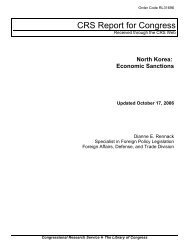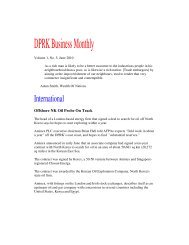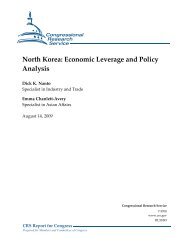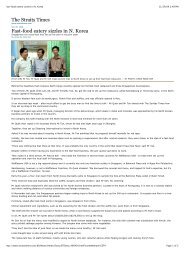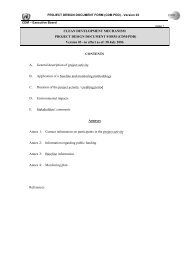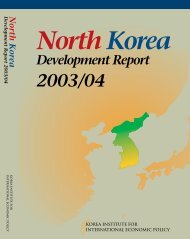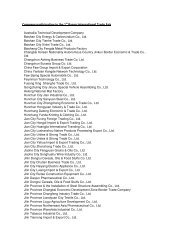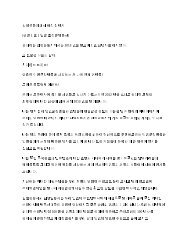North Korean Policy Elites - Defense Technical Information Center
North Korean Policy Elites - Defense Technical Information Center
North Korean Policy Elites - Defense Technical Information Center
You also want an ePaper? Increase the reach of your titles
YUMPU automatically turns print PDFs into web optimized ePapers that Google loves.
promotions) and punishments (e.g., angry criticism, demotions, and purges), Kim keeps<br />
everyone else on their toes as well. Anxiety is the price of elite membership.<br />
Political rank as indicated by “platform ranking” on important state occasions is only a<br />
rough estimate of a person’s political power. To know more accurately how powerful someone is,<br />
it is necessary to know how closely that person works with Kim Jong-il. Bermudez makes the<br />
important point that in <strong>North</strong> Korea (as in other societies), people in staff positions supporting<br />
the high-profile elite themselves have power that derives from their affiliation with their<br />
superiors and from the information they have access to. Gause studies the informal leadership<br />
structure of the Kim Jong-il patronage system as a guide to where power lies, emphasizing in<br />
particular the importance of the first vice director level in organizations.<br />
What is the closest thing to elite factions, if they do not exist in the strictest sense?<br />
Bermudez speaks of the five “societal groupings” mentioned above. Gause quotes defectors as<br />
painting “a rather benign picture of factionalism in <strong>North</strong> Korea”: a factionalism that is “firmly<br />
ensconced at the second echelon of the leadership and is tied to various policy initiatives.” Gause<br />
sees these factional divisions as related to different generations and different institutions, as well<br />
as to different policy initiatives. “Factionalism as it exists today is focused on garnering<br />
influence with the Suryong, not trying to depose him.” Gause believes that in the future “if the<br />
Kim regime loses its ability to placate the elite through goods and services, there is a real chance<br />
of the creation of factions,” citing rumored “cracks” that exist “within Kim Jong-il’s core<br />
constituency.” “This can be transformed into warlordism when the system comes under duress at<br />
the top.”<br />
Hassig explains the consensus conclusion that “No known political divisions among the<br />
elite could fairly be called ‘factions’; that is, organized or semi-organized groups working<br />
against other groups or against the regime” by suggesting that “by the time the identity of any<br />
such group came to the attention of foreign analysts, the group would already have been<br />
exterminated.” He believes it is more accurate to speak of “divisions” or “segments” or<br />
“aggregations of the elite, not organized as formal or even informal groups, which share ideas<br />
and interests at variance with official ideology.” He characterizes as only speculative the<br />
assertions of some <strong>North</strong> Korea observers that the elite are divided on such dimensions as<br />
“hardliners versus soft-liners, military versus party personnel, members of Kim Il-sung’s<br />
different families . . . members of Kim Jong-il’s different families . . . older versus younger<br />
generation elites, technocrats versus ideologues, economy-first versus military-first policy<br />
makers, and nationalists versus internationalists, to name a few.”<br />
VI-3



